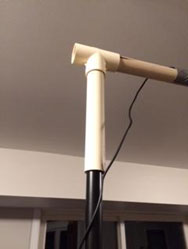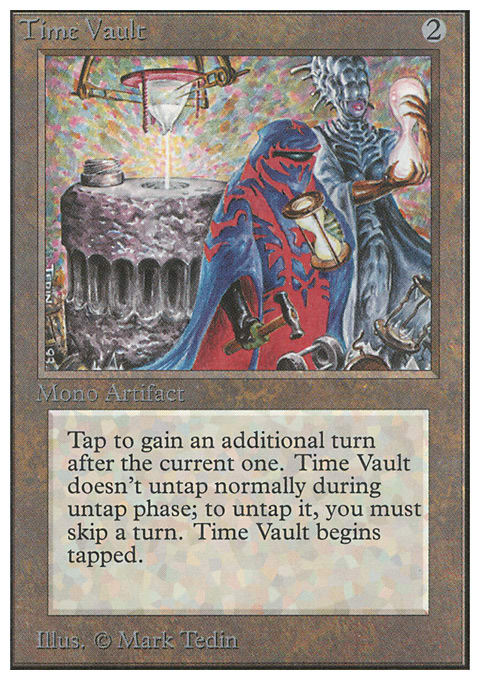It has become somewhat of a tradition among the Midwest Vintage players and their affiliates who make up Team Serious to host an end-of-the-year holiday party and invitational Vintage tournament. It’s a fantastic excuse to hang out with friends and play some of the greatest format in Magic.
Highlights of this Invitational included a door-prize drawing of Vintage foils for everyone who played, a Star Wars Cube Draft side event with first-place getting a lightsaber (foil Sword of Fire and Ice), a lunch break and provided dinner, a kitten, and a fully stocked bar.
Maybe Ben “Doctor Superstition” Perry described it best in his (sometimes NSFW) MTG Underground blog:
This December, as the previous December, my cousin Geoff and his wife Sarah hosted, with all the grace (and patience) an event of this magnitude deserves. Many thanks go out to them. We’re already looking forward to the next opportunity to play Vintage together as a team.
The three most recent Invitationals have been streamed on Twitch and then archived on YouTube, and for this latest event, we enlisted the help of Andy “Brass Man” Probasco to help coordinate the stream and provide commentary. He did a great job, interpreting game states, relating Vintage plays to audiences who might not be familiar with the format, and providing valuable filler during some of the event’s slower periods between matches and games. He even did postgame interviews. The YouTube playlist is complete, and if you’re interested in Vintage and player-hosted events, I highly recommend watching.
The Top 8 decks (out of twenty-two) included U/R Delver with Price of Progress, Dark Petition Storm, two Hangarback Walker Workshop Aggro, Tiny Robots (a Workshop aggro deck with Genesis Chamber), and W/U/r Monastery Mentor Tempo. The finals pitted Justin Waller’s Grixis Pyromancer deck against Jake Hilty and his Painter's Servants. Winners took home dual lands and other prizes, and first place won a signed Unlimited Edition Time Vault!
Jake won with Painter's Servant/Grindstone. It’s a well-positioned combo deck currently because it allows and encourages running maindeck Pyroblast and Red Elemental Blast, which become one-mana Vindicates with Painter's Servant turning the world blue. The blasts, of course, are also good against a blue-dominated format like Vintage.
Grixis Painter ? Vintage | Jake Hilty
- Creatures (4)
- 1 Sphinx of the Steel Wind
- 3 Painter's Servant
- Planeswalkers (2)
- 2 Dack Fayden
- Spells (40)
- 1 Ancestral Recall
- 1 Brainstorm
- 1 Dig Through Time
- 1 Red Elemental Blast
- 1 Vampiric Tutor
- 2 Gush
- 3 Mental Misstep
- 4 Force of Will
- 4 Pyroblast
- 4 Thirst for Knowledge
- 1 Demonic Tutor
- 1 Time Walk
- 1 Tinker
- 1 Treasure Cruise
- 1 Yawgmoth's Will
- 1 Black Lotus
- 1 Lotus Petal
- 1 Mana Vault
- 1 Mox Emerald
- 1 Mox Jet
- 1 Mox Pearl
- 1 Mox Ruby
- 1 Mox Sapphire
- 1 Sol Ring
- 3 Grindstone
- 1 Mox Opal
- Lands (14)
- 2 Island
- 1 Misty Rainforest
- 1 Polluted Delta
- 2 Underground Sea
- 3 Volcanic Island
- 4 Scalding Tarn
- 1 Tolarian Academy
- Sideboard (15)
- 1 Propaganda
- 1 Notion Thief
- 4 Grafdigger's Cage
- 2 Mindbreak Trap
- 3 Ingot Chewer
- 2 Shattering Spree
- 1 Tormod's Crypt
- 1 Mountain
The other high point of this deck is the strength of its draw engine. For people who ask if it’s possible to run Gush and Thirst for Knowledge side by side, it is, and this deck is a great example. The Painter/Grindstone combo is relatively mana-light, especially since its parts can be played separately, so Gush returning two lands won’t set the caster too far back. The combo is also artifact-based, meaning there are plenty of pieces to draw and discard to Thirst, along with all of the artifact mana. Draw spells like these pressure an opponent to counter them to avoid falling behind, meaning when it comes time to go into the combo, the path is often clear.
If you watch the video of the finals, you’ll also note some supporting evidence for my previous article. Jake chose Sphinx of the Steel Wind as a Tinker target specifically because it ignores a lot of Delver’s best answers, namely a swarm of small creatures, Pyroblast, and Dack Fayden. It’s also relatively easy to hard-cast compared to Blightsteel Colossus, which Jake demonstrated by doing just that twice in the finals match.
And Justin went home, always a bridesmaid, never a bride, now finishing second in two consecutive Invitationals. His deck was essentially a modified U/R Delver list that uses Young Pyromancer and disruption to make sure your opponent can’t win before you do.
Grixis Pyromancer ? Vintage | Justin Waller
- Creatures (6)
- 4 Young Pyromancer
- 2 Jace, Vryn's Prodigy
- Planeswalkers (2)
- 2 Dack Fayden
- Spells (38)
- 1 Ancestral Recall
- 1 Brainstorm
- 1 Dig Through Time
- 1 Flusterstorm
- 3 Gush
- 3 Lightning Bolt
- 4 Force of Will
- 4 Mental Misstep
- 1 Demonic Tutor
- 1 Ponder
- 1 Time Walk
- 1 Treasure Cruise
- 1 Yawgmoth's Will
- 3 Preordain
- 4 Cabal Therapy
- 4 Gitaxian Probe
- 1 Black Lotus
- 1 Mox Jet
- 1 Mox Ruby
- 1 Mox Sapphire
- Lands (14)
- 1 Island
- 1 Strip Mine
- 2 Underground Sea
- 3 Polluted Delta
- 3 Volcanic Island
- 4 Flooded Strand
- Sideboard (15)
- 1 Electrickery
- 3 Grafdigger's Cage
- 3 Pyroblast
- 1 Shattering Spree
- 3 Leyline of the Void
- 1 Hurkyl's Recall
- 3 Ingot Chewer
Justin spent several rounds on camera, but probably the best moments are in Game 2 of the finals when, against one of Jake’s hard-cast Sphinxes, Justin combos furiously and makes like thirty Elementals. There are a lot of free draw spells and cantrips in the list, there is good card advantage from Ancestral Recall, Dig Through Time, and Treasure Cruise, and, of course, Yawgmoth's Will lets you do it all again. When your only out to a Tinkerbot is to race it, you do what you have to.
The rest of Justin’s deck is a disruption machine: Gitaxian Probe into Cabal Therapy with Young Pyromancer in play puts your plan forward and your opponent’s plan back. Elemental tokens mean there is plenty of opportunity to Therapy again without losing materiel, and Jace, Telepath Unbound, provides additional uses for any cantrips and card advantage, including alternate-cost Gush (since Jace’s ability is worded like Yawgmoth's Will and not flashback).
Grixis Pyromancer might not have any game-breaking plays like Tinker or setting up Time Vault with Voltaic Key, but all of the small and mid-level advantages add up quickly. It’s a threatening deck to any opponent who stumbles or who can’t set up his or her own, bigger advantages quickly.
 Streaming Vintage tournaments has been on the Team Serious agenda for a couple years, and last summer, we put things into motion. I bought a new, more powerful laptop, and a high-definition webcam and worked on setting up a framework that could tie things together.
Streaming Vintage tournaments has been on the Team Serious agenda for a couple years, and last summer, we put things into motion. I bought a new, more powerful laptop, and a high-definition webcam and worked on setting up a framework that could tie things together.
The rig was the challenge: It had to be reasonably portable and also adjust to different settings. Since we hold tournaments at different stores and other locations, things had to work over different lengths and widths of table. Ideally, it would work with different lighting and sound conditions as well. Obviously, it would be possible to put any amount of work or money into it, but we had to start somewhere and could potentially add onto it and improve it as we go.
What we ended up with was surprisingly simple, the result of a couple hours shopping at Best Buy and Home Depot.
As we were discussing options, one of our teammates—Matt Hazard, lighting director for the Ohio State University theater department—suggested a light stand similar to those photographers use. I searched online and found that they could be purchased locally. It was perfect: inexpensive and adjustable to various heights, up to eight feet with some stability. The one problem was figuring how to make the vertical stand hold a camera out horizontally.
Camera- and lighting-supply companies do sell various arms, extensions, and other accessories for the stands, but we needed something quicker and uglier.
 |  |
For approximately $4 in additional parts, I constructed the attachment in Figure 2. It’s a one-inch PVC T-junction affixed to the light pole with an eight-inch section of PVC piping. Coming out the horizontal is a one-inch dowel that the camera can be secured to, suspended over the play area, as in Figure 3.
 Ideally, the dowel can be supported on the other end (at the Invitational, we had it propped on some exercise equipment, as in Figure 4), but the structure is strong enough to support the camera on its own and is stable enough to not collapse if someone bumps into it, though it might need some adjustment back into place. Additional support could be made regularly available by having a second, similarly constructed stand for the other side. With a long enough dowel, you potentially could span a table and set up two cameras over neighboring games.
Ideally, the dowel can be supported on the other end (at the Invitational, we had it propped on some exercise equipment, as in Figure 4), but the structure is strong enough to support the camera on its own and is stable enough to not collapse if someone bumps into it, though it might need some adjustment back into place. Additional support could be made regularly available by having a second, similarly constructed stand for the other side. With a long enough dowel, you potentially could span a table and set up two cameras over neighboring games.
For lighting, a couple of clamp-lamps and extension cords have worked well. Just make sure the lights aren’t positioned behind the camera, where they will cause glare. Even on sleeves, we haven’t had too much problem.
Beyond that, it was just a matter of setting up an account at Twitch.tv and finding software to link the cameras to Twitch. (We use Open Broadcaster Software, but I’m sure there are other options to explore as well.)
Other groups use more elaborate setups, especially where they can be left in place at a store or someone’s house, but this has been great for our purposes. We’ve streamed several tournaments, and I’ve set it up over my kitchen table to show Team Serious Vintage testing sessions. It’s fun! And there’s a hunger to watch Vintage among its regular players and people who are just getting into it. The Vintage Super League has done a lot to spark interest in the format, at least as a spectator sport.
It appears 2016 is shaping up to follow 2015 as a great year for Vintage. Again, we’ll have more visibility from the Vintage Super League, online Vintage in general, and new streamers, so I’m looking forward to record turnouts at big events like June’s NYSE Open IV and the 2016 Vintage Championship. It’s a great time to get into the format and join the fun, one way or another.
Game on!
Nat Moes



























